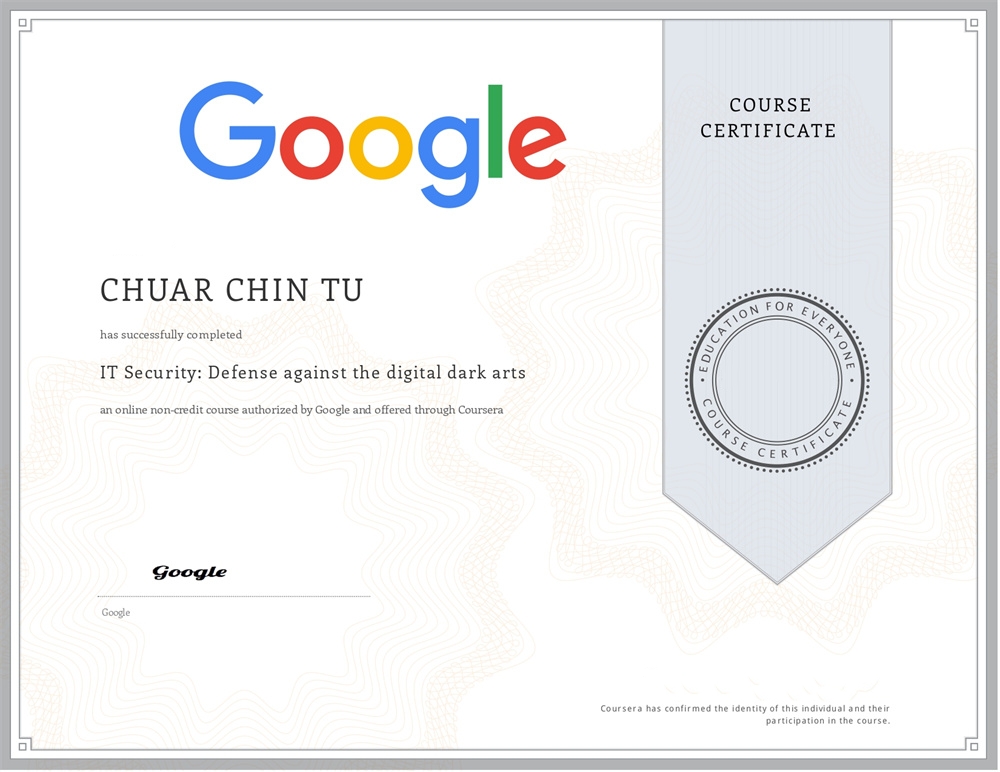Eric Chuar has completed the IT Security Defense against the digital dark arts for Personal & Professional Productivity and received a certificate from Google.
SCHOOL:
Google
GRADUATED:
2018
DURATION:
6 Months

Software Developer Skills Gained
Basics of security in an IT environment. Learn how to define and recognize security risks, vulnerabilities and threats. Identify the most common security attacks in an organization and understand how security revolves around the “CIA” principle. Types of malicious software, network attacks, client-side attacks, and the essential security terms in the workplace.
Learn about cryptology. Explore different types of encryption practices and how they work. Most common algorithms used in cryptography and how they’ve evolved over time. Understand how symmetric encryption, asymmetric encryption, and hashing work; Choose the most appropriate cryptographic method for a scenario see in the workplace.
Important to understand how authentication, authorization, and accounting work within an organization. Able to choose the most appropriate method of authentication, authorization, and level of access granted for users in an organization.
Learn about secure network architecture. How to implement security measures on a network environment, so we’ll show you some of the best practices to protect an organization’s network. The risks of wireless networks and how to mitigate.
Course Perspective
Just finished the IT Security: Defense Against the Digital Dark Arts course, and man, was it eye-opening. Look, I’ve always been hands-on with tech stuff, even before stepping into any formal learning. Certificates are cool and all, but knowing the ins and outs—that’s where the real fun is.
Security Basics: The course started with the ABCs of IT security. We’re talking about defining what security risks, vulnerabilities, and threats really mean. They also hit us with the “CIA” principle—Confidentiality, Integrity, and Availability, which was like the North Star guiding the whole course.
Cryptology: Then we dove into the deep end with cryptology. I got to explore various types of encryption practices. From symmetric to asymmetric encryption, and even hashing—the course covered it all. This was like the superhero toolkit for anyone dealing with sensitive data.
AAA—Authentication, Authorization, Accounting: This was the next big thing. How do you make sure the right people have the right access? The course gave some solid pointers on selecting the best methods for authentication and authorization, which is kinda essential if you want to keep your organization’s data safe.
Secure Network Architecture: Last but definitely not least, we tackled secure network architecture. This is where things got real. They showed us the best practices to fortify an organization’s network and even touched upon the risks in wireless networks.
Why did I take this course? Well, I’m rooted in digital marketing and programming, and in today’s world, understanding IT security is non-negotiable. Especially when you’re passionate about sharing what you know—like me. I’ve been in Malaysia and Singapore for a long time, and let me tell you, people here are thirsty for this kind of knowledge.
At the end of the day, I’m just a guy who loves learning and sharing what I know. Got a family and a little one who looks up to me. So why not add one more thing to share, right? Whether it’s digital marketing, programming, or even my secret badminton techniques, I’m all about spreading the knowledge. Life’s too short to keep everything to yourself. Can’t wait to apply what I’ve learned and help others up their game too.
